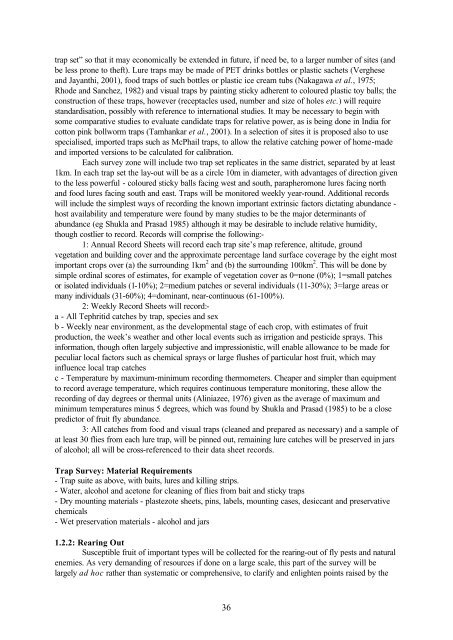“Key Informant Survey” of Production, Value, Losses and ... - DfID
“Key Informant Survey” of Production, Value, Losses and ... - DfID
“Key Informant Survey” of Production, Value, Losses and ... - DfID
You also want an ePaper? Increase the reach of your titles
YUMPU automatically turns print PDFs into web optimized ePapers that Google loves.
trap set” so that it may economically be extended in future, if need be, to a larger number <strong>of</strong> sites (<strong>and</strong><br />
be less prone to theft). Lure traps may be made <strong>of</strong> PET drinks bottles or plastic sachets (Verghese<br />
<strong>and</strong> Jayanthi, 2001), food traps <strong>of</strong> such bottles or plastic ice cream tubs (Nakagawa et al., 1975;<br />
Rhode <strong>and</strong> Sanchez, 1982) <strong>and</strong> visual traps by painting sticky adherent to coloured plastic toy balls; the<br />
construction <strong>of</strong> these traps, however (receptacles used, number <strong>and</strong> size <strong>of</strong> holes etc.) will require<br />
st<strong>and</strong>ardisation, possibly with reference to international studies. It may be necessary to begin with<br />
some comparative studies to evaluate c<strong>and</strong>idate traps for relative power, as is being done in India for<br />
cotton pink bollworm traps (Tamhankar et al., 2001). In a selection <strong>of</strong> sites it is proposed also to use<br />
specialised, imported traps such as McPhail traps, to allow the relative catching power <strong>of</strong> home-made<br />
<strong>and</strong> imported versions to be calculated for calibration.<br />
Each survey zone will include two trap set replicates in the same district, separated by at least<br />
1km. In each trap set the lay-out will be as a circle 10m in diameter, with advantages <strong>of</strong> direction given<br />
to the less powerful - coloured sticky balls facing west <strong>and</strong> south, parapheromone lures facing north<br />
<strong>and</strong> food lures facing south <strong>and</strong> east. Traps will be monitored weekly year-round. Additional records<br />
will include the simplest ways <strong>of</strong> recording the known important extrinsic factors dictating abundance -<br />
host availability <strong>and</strong> temperature were found by many studies to be the major determinants <strong>of</strong><br />
abundance (eg Shukla <strong>and</strong> Prasad 1985) although it may be desirable to include relative humidity,<br />
though costlier to record. Records will comprise the following:-<br />
1: Annual Record Sheets will record each trap site’s map reference, altitude, ground<br />
vegetation <strong>and</strong> building cover <strong>and</strong> the approximate percentage l<strong>and</strong> surface coverage by the eight most<br />
important crops over (a) the surrounding 1km 2 <strong>and</strong> (b) the surrounding 100km 2 . This will be done by<br />
simple ordinal scores <strong>of</strong> estimates, for example <strong>of</strong> vegetation cover as 0=none (0%); 1=small patches<br />
or isolated individuals (1-10%); 2=medium patches or several individuals (11-30%); 3=large areas or<br />
many individuals (31-60%); 4=dominant, near-continuous (61-100%).<br />
2: Weekly Record Sheets will record:-<br />
a - All Tephritid catches by trap, species <strong>and</strong> sex<br />
b - Weekly near environment, as the developmental stage <strong>of</strong> each crop, with estimates <strong>of</strong> fruit<br />
production, the week’s weather <strong>and</strong> other local events such as irrigation <strong>and</strong> pesticide sprays. This<br />
information, though <strong>of</strong>ten largely subjective <strong>and</strong> impressionistic, will enable allowance to be made for<br />
peculiar local factors such as chemical sprays or large flushes <strong>of</strong> particular host fruit, which may<br />
influence local trap catches<br />
c - Temperature by maximum-minimum recording thermometers. Cheaper <strong>and</strong> simpler than equipment<br />
to record average temperature, which requires continuous temperature monitoring, these allow the<br />
recording <strong>of</strong> day degrees or thermal units (Aliniazee, 1976) given as the average <strong>of</strong> maximum <strong>and</strong><br />
minimum temperatures minus 5 degrees, which was found by Shukla <strong>and</strong> Prasad (1985) to be a close<br />
predictor <strong>of</strong> fruit fly abundance.<br />
3: All catches from food <strong>and</strong> visual traps (cleaned <strong>and</strong> prepared as necessary) <strong>and</strong> a sample <strong>of</strong><br />
at least 30 flies from each lure trap, will be pinned out, remaining lure catches will be preserved in jars<br />
<strong>of</strong> alcohol; all will be cross-referenced to their data sheet records.<br />
Trap Survey: Material Requirements<br />
- Trap suite as above, with baits, lures <strong>and</strong> killing strips.<br />
- Water, alcohol <strong>and</strong> acetone for cleaning <strong>of</strong> flies from bait <strong>and</strong> sticky traps<br />
- Dry mounting materials - plastezote sheets, pins, labels, mounting cases, desiccant <strong>and</strong> preservative<br />
chemicals<br />
- Wet preservation materials - alcohol <strong>and</strong> jars<br />
1.2.2: Rearing Out<br />
Susceptible fruit <strong>of</strong> important types will be collected for the rearing-out <strong>of</strong> fly pests <strong>and</strong> natural<br />
enemies. As very dem<strong>and</strong>ing <strong>of</strong> resources if done on a large scale, this part <strong>of</strong> the survey will be<br />
largely ad hoc rather than systematic or comprehensive, to clarify <strong>and</strong> enlighten points raised by the<br />
36

















